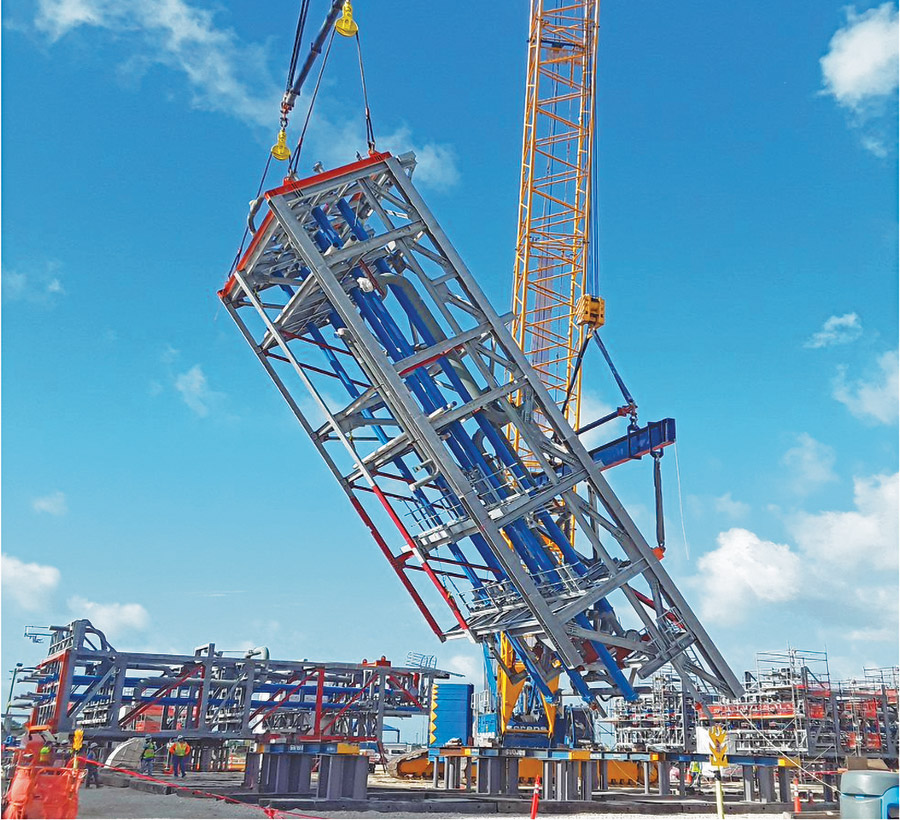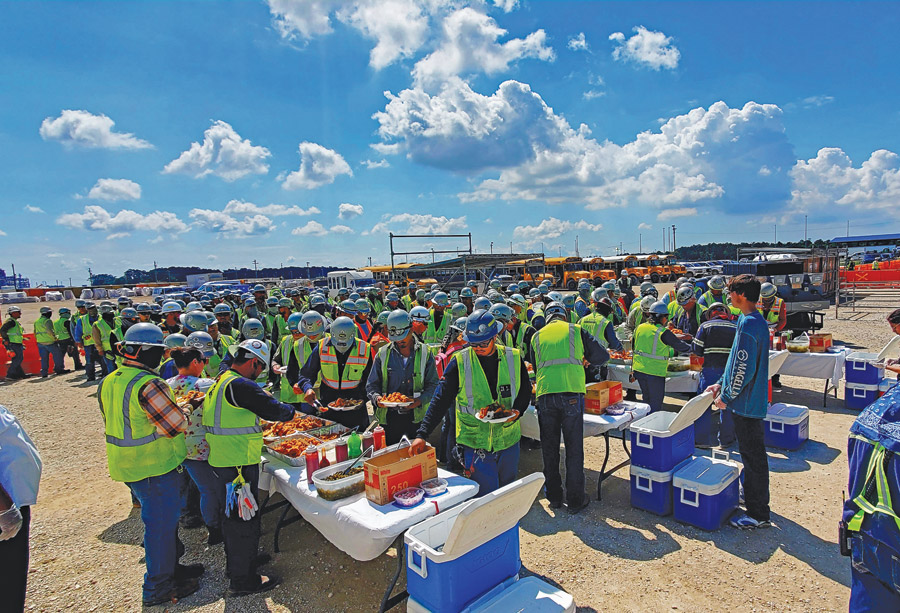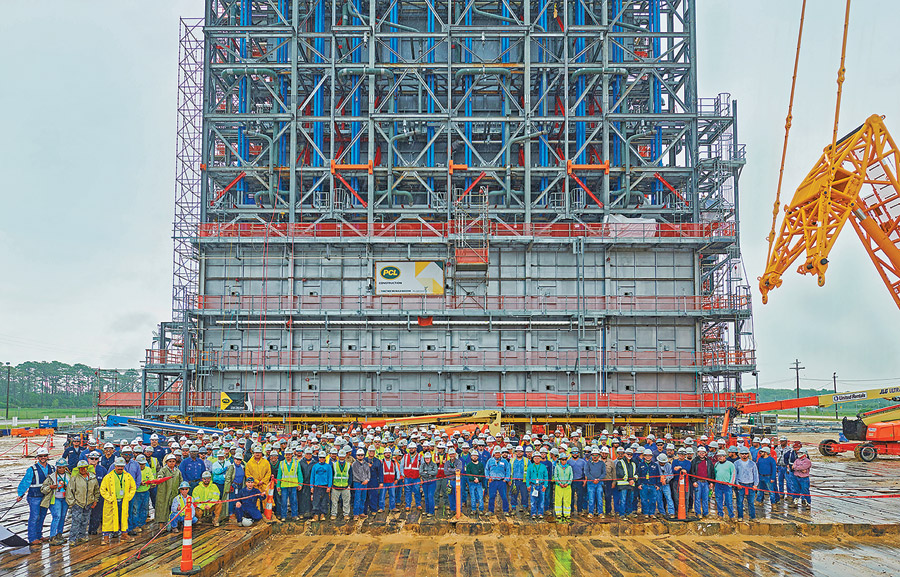2024 Texas & Louisiana Best Projects
Project of the Year — Baytown 'Supermodule' Project Proves a Moving Experience

The supermodule being transported down the one-mile road to be installed into the live facility.
Photo by Michael Rowland
BAYTOWN SUPERMODULE FURNACE PROJECT
Baytown, Texas
BEST PROJECT, ENERGY/INDUSTRIAL
KEY PLAYERS
Submitted by: PCL Industrial Construction Co.
OWNER Chevron Phillips Chemical Co.
LEAD DESIGN FIRM Technip Energies
GENERAL CONTRACTOR PCL Industrial Construction Co.
TRANSPORTATION SERVICES Mammoet USA South Inc.
Early on the morning of Sept. 24, 2022, three six-trailer lines of self-propelled modular transporters (SPMTs) groaned into motion for a one-mile journey across Chevron Phillips Chemical Co.’s Baytown, Texas, ethylene plant. The relatively short distance contrasted with the carriers’ massive cargo: a 2,800-ton, 128-ft by 139-ft by 62-ft cracking furnace that would be carefully positioned alongside the plant’s eight existing units.
Built by PCL Industrial Construction Co., the “supermodule” itself was a unique feat of engineering and construction, having been modeled and adapted from an existing furnace design over a period of two years beginning in late 2019, then pre-assembled at a laydown area outside the plant. Along with the furnace, PCL’s scope included all associated steel, pipe, equipment, electrical, instrumentation, painting, refractory and insulation work.
Though the project would be Chevron Phillips Chemical’s first experience with modularization, PCL project director Danny Evans explains that the approach offered many advantages compared with stick-building the new unit in place adjacent to the existing, operational furnaces.

Modular construction began at ground level with furnace preassembly in the laydown area one mile away from the live facility.
Photo by Danny Evans
“Our access would be limited to where we could work only on one side at a time,” Evans says. “By building the furnace off site, we would have access to all four sides, which would help us work faster and reduce costs.”
Offsite modularization would also provide a safer working environment. In addition to being removed from the hazards of a “live” industrial setting, construction activity could take place at or near ground level rather than several dozen feet in the air.
“Being able to spread out also made us more productive because we weren’t working on top of each other,” adds PCL project manager Stephen Reinke.

The team celebrated safety milestones throughout the project. The project finished with 648,874 safe work hours and zero lost-time injuries.
Photo by Danny Evans
The Making of a Supermodule
Planning and preconstruction for the highly complex project, which began in September 2019, demanded a highly coordinated effort between PCL, Chevron Phillips Chemical and Netherlands-based furnace designer Technip Energies. Function and transport considerations influenced each other as the design evolved. In addition to revising the structural system to accommodate the weight of the modules, for example, reengineering the original furnace configuration into workable modules that would operate reliably and efficiently after assembly—and have a total weight of less than 3,000 tons—also had to consider structural supports necessary to ensure stability both during construction and transport.
For the temporary transport beams incorporated into the radiant box substructure, for example, “the engineering and constructibility teams had to know how many SPMT lines we’d put in, their capacities and where center of gravity would hit,” Evans says. Similarly, the concrete pedestals at the final location were modified to accommodate SPMT wheels when the supermodule arrived for placement.
“By building the furnace off site, we would have access to all four sides, which would help us work faster.”
—Danny Evans, Project Director, PCL Industrial
According to PCL, the furnace’s modularization strategy resulted in four major preassemblies and 17 modules, with a level of detail that included how each piece of the submodules interconnected throughout the craft disciplines.
The complex assembly process began in September 2021 amid lingering pandemic-related supply issues, requiring nimble management of the project’s trade workforce as some material deliveries were delayed by up to two months.
As new layers were added to the supermodule, the project team sought to mitigate new challenges that the Gulf Coast’s notoriously humid and sometimes volatile climate might throw its way. A network of high-tech environmental sensors helped safeguard the furnace refractory and sensitive instruments from excessive humidity and temperature conditions.
Had a major hurricane threatened the jobsite, the team was ready with twelve 5.5-ft x 60-ft drilled caissons and sufficient rigging to strap the structure down. Though the region was spared major storms during construction, the caissons and rigging were utilized to help maintain the supermodule’s alignment as new module sections were added.

The project marked a massive addition to Chevron Phillips Chemical Co.’s Baytown, Texas, ethylene plant.
Photo by Danny Evans
Motion Control
Meanwhile, PCL prepared for moving day by conducting extensive surveys and test runs with the SPMTs laden with crane counterweights to ensure all existing surfaces along the one-mile transport route to the installation point could safely support the massive loads. Transitioning from the assembly site to an adjacent heavy haul road, the SPMTs would travel for approximately a half-mile, then turn on to a smaller plant access road that, while capable of supporting the transport, would be covered with crane mats to protect the paved surface from damage.
In the weeks and days leading up to the move, “we checked, rechecked and triple-checked every element to make sure the journey would be flawless,” Evans says. “We felt very confident we were going to make it.”

Layer by layer, the convection modules were strategically stacked until the furnace reached the size of a mid-rise apartment building.
Photo by Danny Evans
The only variable the team had to watch, Reinke adds, was the wind. “We were allowed 1 degree of pitch,” he says, “but the conditions that day were perfect.”
Once in motion, the SPMTs—with their more than 400 tires—inched their way along the route at no more than 2 mph. After some deftly executed turns to align the furnace with its foundation pedestals, the SPMTs carefully backed the unit into position.
Five hours after the move began, the furnace was in place. Tie-in work would be completed the following August. Completed on schedule in 12 months—half the time of a conventional stick-built project—the supermodule’s construction phase totaled nearly 649,000 work hours with no lost-time incidents.

The project team celebrates the unique achievement of installing the supermodule.
Photo by Dave Shafer
PCL is now adapting the successful Baytown modularization approach to build seven ethylene cracker furnaces of a similar size at a separate Chevron Phillips Chemical facility in Texas. Evans calls the new project approach “a hybrid,” in which modular sections are being stacked in place rather than assembled off site.
According to Todd Hoffman, project manager for Chevron Phillips Chemical, planning and coordinating a project as unique as the Baytown supermodule furnace “required a special dedication, commitment and creativeness that few contractors possess. It helped me sleep at night knowing that we had professionals from preconstruction to execution to closeout.”
The key to the project’s success, Evans says, was the seamless collaboration of owner, engineer and contractor.
“It was like we were one company,” he says. “We had difficult conversations at times, but we always came out unified. I’ve been in construction for more than 40 years, and this is the best job I’ve worked on.”




